Grilled octopus over squid ink pasta and tomato garlic sauce – twice cooked, tender octopus, served over spicy, squid ink spaghetti, and the best tomato garlic sauce – this recipe will knock your socks off with its frightfully delicious flavors, spooky looks, and dramatic presentation, making it the perfect Halloween night dish.
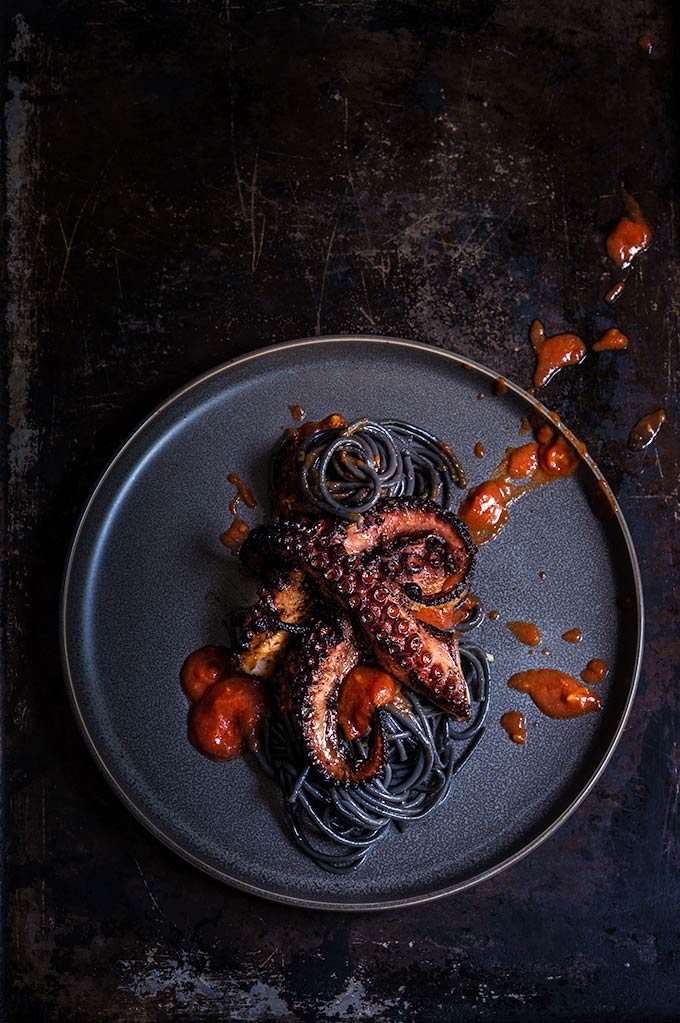
If cooking octopus seems a bit intimidating, or makes you squeamish, nobody can blame you. After all, this eight-legged, slimy creature, with its greyish, slippery skin, and a limp sac of a head, is not for the faint of heart. But if you love seafood as much as I do, and if you have an adventurous mind, and explorer’s appetite, you must get over your squeamishness, and tackle this beast! You might be surprised to find out that you actually enjoy the process, especially after the end result!

I have to admit, I was so mesmerized by this creature, I took countless pictures of its overflowing body, with its curling, suction-cupped tentacles, dripping all over, in beautiful random patterns. With its scary beak (yes, beak as in ‘bird’s beak’), which made it resemble a one-eyed monster, and its sinister look, it was an infinite source of inspiration, and since I was already in a perfectly fitting, macabre mood, we had some pretty good time – my model and I.

But after the initial courting, it was time for the gory details – chopping off the head, and removing the beak! It was a bit unnerving (especially the beak removal), but overall wasn’t too bad. Hey, at least there was no blood, and I didn’t have to remove other organs. If I (who cannot look a praying mantis in the face without shuddering), can do it, you can do it too! In the name of that sweet and succulent, octopus grilled meat – you have to!
Apart from satisfying my photography passions, the octopus ultimately satisfied my culinary curiosity and gastronomical cravings as well. As I cooked the devil out of it, it transformed into a frightfully delicious, tender piece of white meat, and boy, was it worth it!
How to cook octopus
The first time I bought octopus, I did a good amount of searching for the best ways to cook it, and the more I read, the more it seemed like going through a maze – at each intersection there are multiple routs you can take, and the end result is unknown. Yet, after awhile, a few clear steps emerged: 1) tenderize the octopus 2) cook it slowly in liquid 3) marinade and/or grill. Technically, your octopus is done after step 2). At this point, you can cut it up, marinade or dress up, to serve in a cold salad preparation, or finish off on the grill to give it a nicely charred surface. Alternatively, you can do both – marinade, and then grill – but I found this unnecessary.
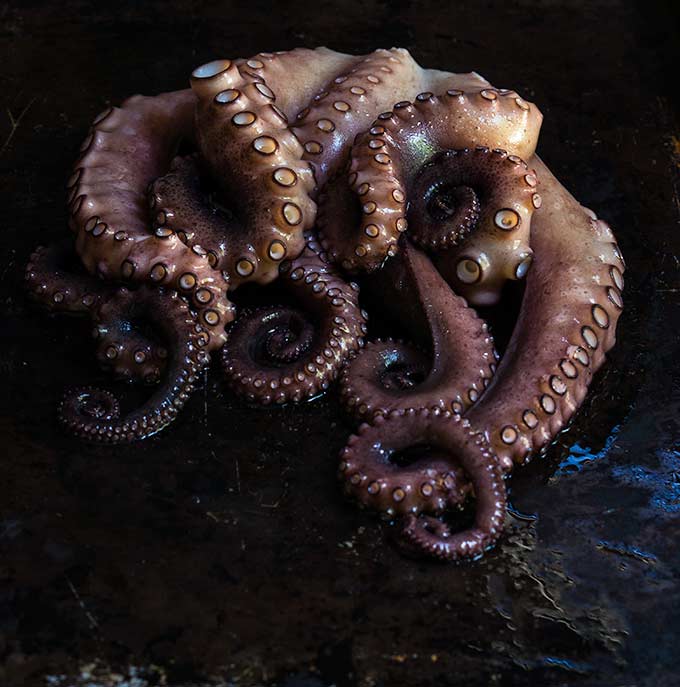
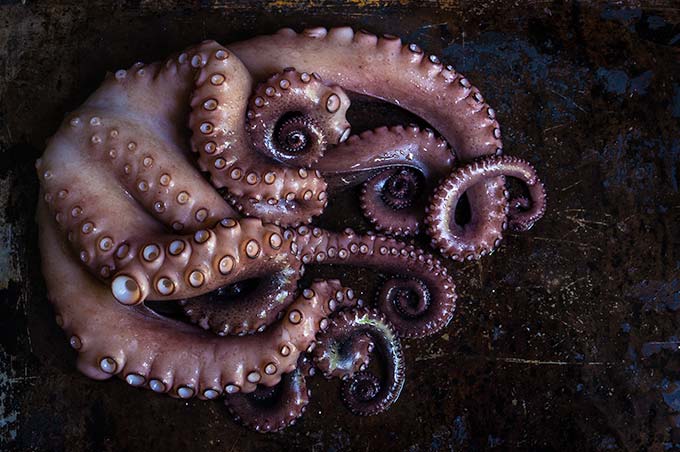
Curled up and purple, after a quick dip in boiling water.
1. Tenderize the octopus
There are different theories on how to tenderize the octopus meat, depending on which part of the world you are in. From beating it against the rocks (as they do in Greece), to braising it with wine corks thrown in the liquid (like the Italians), dipping 3 times in boiling water (like the Spanish), or simply freezing and thawing the octopus – these are all tried and true techniques that should transform the tough, rubbery octopus flesh into a palatble, tender meat. I decided to skip the beating (for obvious reasons), and go for a combination of the other three – freezing/defrosting, dipping 3 times in boiling water, then cooking the creature in aromatic broth with a few corks thrown in.
Freeze and thaw: Most of us do not have access to fresh seafood, so chances are, your octopus has already been frozen by the time it reaches your local store counter, and you don’t have to do anything. But be sure to ask your fish monger, and if necessary, freeze the octopus and defrost before cooking. In the process, the cell tissue breaks down, and changes the structure of the meat, making it softer, and less rubbery.
The octopus dip: To perform the 3-times dip, you simply bring water to a boil in a large pot, and holding your octopus with tongs, dip it (tentacles first) in the water for 10 seconds, then remove and repeat 2 more times. Why exactly 3 times? Why 10 seconds each? I couldn’t find a satisfactory explanation for this – some say it helps preserve the skin from falling apart, others say it tenderizes the meat, but I suspect it’s mostly done for the looks, as it created nicely curled, sexy legs (ahem.. tentacles), and presented another photo opp for me (see purplish pictures above).
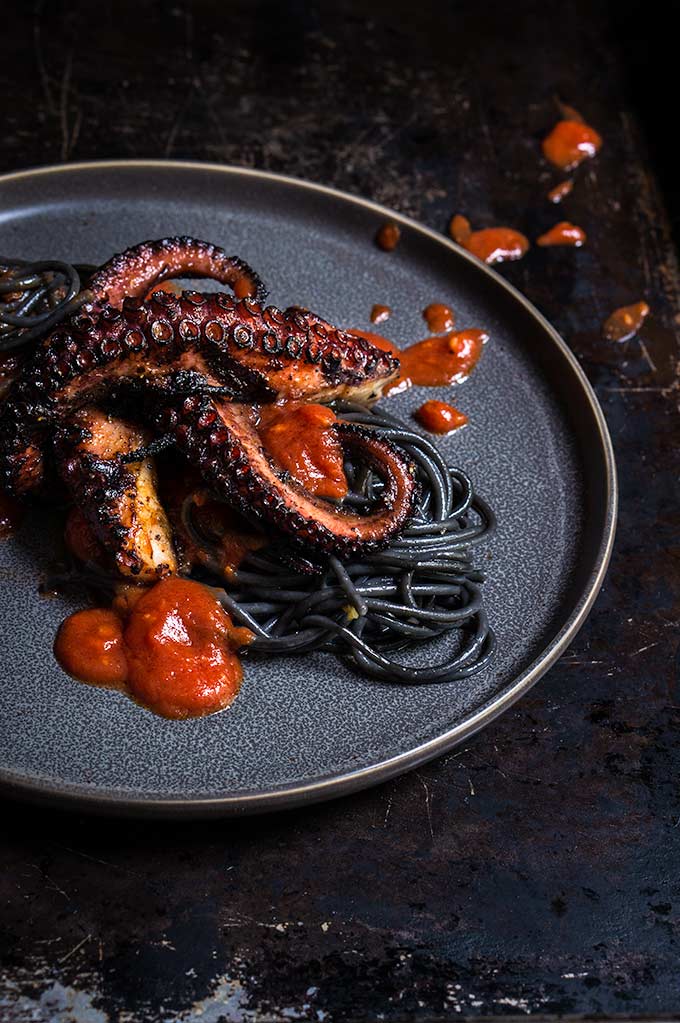
2. Cook slowly
After the initial tenderizing, you proceed to slowly cook the octopus in liquid for about an hour ( or more, depending on its weight) until fork-tender. You can use a combination of water, white wine or red wine, plus a bunch of herbs and aromatics to braise your octopus in. I let the octopus stew in its own oceanic juices (it will release quite a lot of liquid when heated), and added some white wine, chopped garlic and onion, plus dry oregano, salt and pepper. I did not add any water, so as not to dilute the flavors. When you open the bottle of wine, don’t forget to throw the cork in the broth too. Supposedly an enzyme in the cork helps tenderize the flesh. Most famous chefs, like Mario Batali, swear by this technique, and even if you don’t quite believe it, it won’t hurt anyway. I do it, even though my theory is, that as long as you cook the octopus long enough in braising liquid, it will come out nice, and tender.
How to check if it’s ready? Poke it with a sharp knife, and it should meet almost no resistance. If it feels tough, and springy, then continue to cook until soft. At this point, your octopus is cooked and ready to be served in salads, stews, paellas, or in its pure glory. Its skin would have turned a dark maroon color, and will be a bit slimy. You can remove the skin by lightly rubbing it off with a paper towel, or, you can leave it on, especially if planning to grill it.
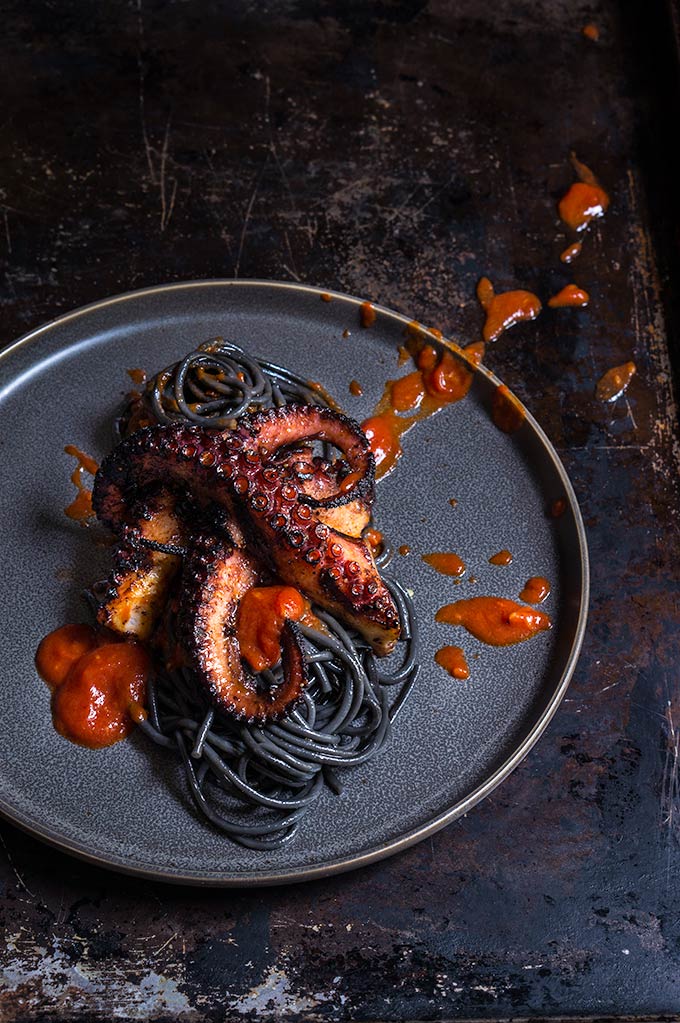
3. Grill
This next step is optional but if you want to get a nice charred, crispy skin (and who doesn’t), proceed to brush your octopus with olive oil, salt and pepper, and throw it on the hot grill for a few minutes. I took it one step further, and used bacon fat, instead of olive oil to give it some extra flavor.
I served my octopus over squid ink spaghetti, tossed in some olive oil, hot pepper flakes, and garlic, plus the bacon pieces. I also made a quicker version of my simple tomato garlic sauce which packs a ton of flavor. It was really delicious, totally worth the effort, and would make the perfect Halloween night dinner, don’t you think?
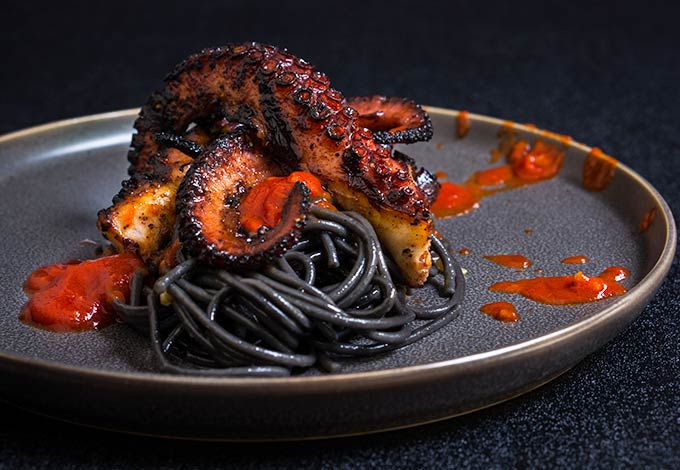
Naturally, I couldn’t convince the kids to try the octopus but they managed to stomach their initial shock, and gulped down the black pasta with the sauce. Oh, and in case you’re wondering, the squid ink pasta, does not have any fishy taste, or smell.
Also, since we’re on the topic, check out this yummy recipe for stuffed calamari in lemon butter sauce.

Grilled octopus over squid ink pasta and tomato garlic sauce - twice cooked, tender octopus, served over spicy, squid ink spaghetti, and the best tomato garlic sauce.
- 1 baby octopus (about 2 pounds)
- 2 cups white wine
- 4 garlic cloves, sliced
- 1 tsp dry oregano
- 1 onion, quartered
- salt and pepper
- 1-2 wine corks
- 3 bacon pieces (used in the last step)
- 1 can tomato sauce
- 2-3 Tbs olive oil
- 3 garlic cloves, pressed
- salt
- 1/2 tsp hot pepper flakes
- 1 garlic clove
- 1/2 package squid ink spaghetti * (or other pasta)
-
If your octopus has not been previously frozen, freeze it overnight, then slowly defrost in the fridge.
-
Cut the head of the octopus below the eyes, and discard if you want. Remove the beak, by gently pulling it. Rinse the octopus.
-
Bring a large pot of water to a boil. Holding the octopus with tongs, dip in the boiling water for 10 seconds, remove, then repeat the dipping 2 more times.
-
Pour out the water, and return the octopus to the same pot. Add the white wine, onion, garlic, and oregano, season with salt and pepper. Cover and bring to a simmer. After 10 minutes, the octopus will have released most of its juices. Check and make sure it's almost completely submerged in liquid. If not, add more wine or water. Reduce heat, and cook for 45-60 minutes, or until fork-tender. Half way through, flip over the octopus, to ensure it's evenly cooked.
-
Heat the olive oil, in a deeper pan, and once hot, add the tomato sauce, and salt. Cook the tomato sauce over medium heat, while stirring all the time, for about 5-7 minutes. Remove from heat, and add the pressed garlic (adding the garlic off the heat is done on purpose, to preserve its fresh taste and aroma). Stir, taste and adjust the salt if needed.
-
Bring a pot of salted water to a rolling boil. Add your pasta, and cook according to instructions. Rinse under cold water, and drain, then add olive oil, and keep in an airtight container, until ready to serve.
-
Right before serving, heat 2 tablespoons of olive oil, and add the hot pepper flakes, and chopped garlic clove. Cook for 30 seconds, then add the pasta, and toss a few times until warmed up, and flavored.
-
Once the octopus is tender, let it cool in its liquid. You can remove the purplish skin if you want, by gently rubbing it off with a paper towel. Cut off the tentacles, and if too long, cut them into smaller pieces.
-
Preheat your grill, or bbq.
-
Chop the bacon, and fry over medium heat until cooked (5-7 min). Remove the bacon pieces with a slotted spoon, and reserve for later. Do not throw away the fat.
-
Brush the cooled off octopus with the bacon fat, season with coarse salt and pepper, and more dry oregano if desired, and grill for a few minutes.
-
Serve the octopus over the squid ink pasta, with the bacon pieces, and pour over the tomato garlic sauce.
* You can find squid ink spaghetti, or other squid ink pasta at specialty food stores.

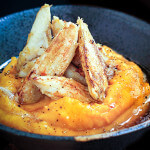



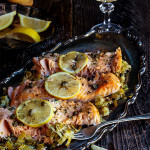
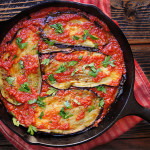

Where is this?
Looks delicious! 😋